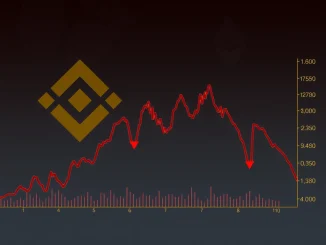
In a groundbreaking move set to redefine institutional engagement with digital assets, Binance has significantly expanded its offerings by integrating USYC and cUSDO as institutional collateral. This strategic development, forged through key partnerships with Circle and OpenEden, marks a pivotal moment in bridging the chasm between traditional finance (TradFi) and decentralized finance (DeFi). For institutional players, this isn’t just another update; it’s a monumental leap towards enhanced capital efficiency and sophisticated risk management within the crypto ecosystem. Imagine a world where the stability of U.S. Treasuries meets the agility of blockchain – that’s precisely what this integration aims to achieve, offering a powerful new tool for leveraging yield-bearing stablecoins.
Bridging the Gap: Binance’s Bold Move in Institutional Collateral
Binance, a global leader in the cryptocurrency exchange space, is no stranger to innovation. Its latest initiative to accept USYC and cUSDO as off-exchange collateral for institutional clients is a clear signal of its commitment to serving the evolving needs of large-scale financial entities. This move directly addresses a critical pain point for institutional traders: optimizing capital utilization while managing inherent market volatility. By allowing these yield-bearing stablecoins to be used as collateral, Binance is enabling its clients to keep their capital working for them, generating returns even when used to back trading positions.
This strategic integration facilitates a smoother flow of capital, allowing custodial partners like Binance Banking Triparty and Ceffu to provide secure custody and settlement. The emphasis here is on compliance and regulatory adherence, ensuring that institutional clients can operate within established frameworks while still benefiting from the speed and efficiency of crypto-native solutions. The instant fungibility with USDC is a particularly attractive feature, providing liquidity and flexibility that are crucial for arbitrage and hedging strategies in dynamic markets.
Understanding USYC and cUSDO: The Yield-Bearing Powerhouses
At the heart of this integration are two innovative digital assets: USYC and cUSDO. These aren’t just any stablecoins; they represent a new generation of tokenized real-world assets (RWAs) designed to offer yield, mirroring traditional financial instruments but with the added advantages of blockchain technology.
- USYC (issued by Circle): This token is backed by U.S. Treasuries, providing holders with yield through interest accruals. Think of it as a tokenized version of a short-term Treasury bill, but one that lives on the blockchain, offering unprecedented accessibility and composability within the DeFi landscape. Its design allows for seamless conversion to USDC, ensuring liquidity and ease of use.
- cUSDO (from OpenEden): Similar to USYC, cUSDO also provides returns on reserves, effectively functioning like a money market fund on-chain. It offers a pathway for institutions to access Treasury-like yields without needing to navigate the complexities of traditional banking systems for every transaction. Its consistent trading volume and healthy premium indicate strong market confidence in its underlying model.
These assets are designed to provide a safer, yield-generating alternative for large firms, especially in an environment of fluctuating interest rates and increasing scrutiny on traditional crypto custodians. They represent a significant step towards bringing the benefits of TradFi’s stability into the DeFi space, offering a hybrid solution that aims to deliver the best of both worlds.
The Rise of Tokenized U.S. Treasuries: A Game Changer?
The concept of tokenized U.S. Treasuries has been gaining immense traction, and for good reason. It represents a powerful fusion of the world’s safest asset class with the transparency and efficiency of blockchain technology. But why is this considered a game-changer for institutions?
Firstly, it democratizes access to U.S. Treasury yields. While large institutions traditionally have direct access, tokenization simplifies the process, reduces friction, and allows for fractional ownership. Secondly, it enhances capital efficiency. Instead of holding idle cash or traditional low-yield assets as collateral, institutions can now use yield-bearing tokens, effectively earning returns on their collateralized positions.
However, it’s crucial to acknowledge the nuances. While the underlying assets are U.S. Treasuries, the token itself introduces counterparty risk. The Treasuries are held in custodial accounts, not directly by the token holders, meaning users rely on the issuer’s solvency and operational integrity. Despite this, the surge in interest for tokenized Treasuries, with demand nearly doubling since early 2025, underscores a clear market appetite for these innovative financial products.
Navigating the TradFi DeFi Bridge: Opportunities and Challenges
The integration of USYC and cUSDO by Binance is a prime example of the ongoing effort to build a robust TradFi DeFi bridge. This bridge aims to combine the regulatory compliance, stability, and deep liquidity of traditional finance with the innovation, transparency, and efficiency of decentralized finance.
Opportunities:
- Enhanced Capital Efficiency: Institutions can now earn yield on their collateral, optimizing returns.
- Increased Liquidity: Tokenized assets offer greater fungibility and ease of transfer compared to traditional securities.
- New Revenue Streams: Access to crypto-native yield generation strategies previously unavailable to TradFi players.
- Streamlined Operations: Blockchain-based settlement can reduce transaction times and operational costs.
Challenges:
- Counterparty Risk: Reliance on the issuer and custodian of the underlying assets.
- Regulatory Uncertainty: The evolving landscape of crypto regulations can pose challenges for adoption and compliance.
- Scalability: Ensuring the yield-generating mechanisms can scale to meet institutional demand without compromising security.
- Education and Adoption: Bridging the knowledge gap between TradFi professionals and the complexities of DeFi.
Circle’s Chief Business Officer, Kash Razzaghi, rightly highlighted the potential for faster capital flow across digital markets, enabling firms to access Treasury-like yields without ever needing to exit the crypto ecosystem. This efficiency is a cornerstone of the TradFi DeFi bridge.
The Broader Impact: RWA Tokenization and Binance’s Strategic Edge
This move by Binance isn’t an isolated event; it’s a significant play within the rapidly expanding sector of RWA tokenization. Real-world assets, ranging from real estate and commodities to government bonds, are being brought onto the blockchain, unlocking new possibilities for liquidity, fractional ownership, and global accessibility.
Binance’s integration of USYC and cUSDO strategically positions it at the forefront of this trend. While rivals like Coinbase and Kraken have also ventured into similar RWA products, Binance’s focus on institutional use cases for collateral in its vast derivatives and lending markets gives it a distinct competitive edge. Collateral efficiency directly impacts trading margins, making this a crucial factor for large-volume traders.
Market data and social sentiment analysis further underscore the bullish outlook for these tokenized assets. Crypto data platforms show growing interest, with key users and market watchers actively rotating capital into USYC and cUSDO. This sustained demand indicates long-term confidence in the model and the broader RWA sector.
Binance’s Catherine Chen emphasized the importance of expanding capital-efficient trading options as a direct response to the evolving needs of institutional participants. This aligns with broader efforts across the industry to integrate traditional financial safety mechanisms with crypto-native tools, setting a precedent for hybrid financial products tailored specifically for institutional clients.
Binance’s integration of USYC and cUSDO as institutional collateral marks a pivotal moment in the evolution of digital finance. By enabling yield-bearing stablecoins backed by U.S. Treasuries to serve as off-exchange collateral, Binance is not only enhancing capital efficiency and risk management for its institutional clients but also solidifying its position as a leader in the burgeoning real-world asset (RWA) tokenization sector. This strategic collaboration with Circle and OpenEden is a powerful testament to the ongoing convergence of traditional finance and decentralized finance, promising a future where the stability of conventional assets seamlessly merges with the innovation and efficiency of blockchain technology. While challenges like counterparty risk and regulatory clarity remain, the clear demand and strategic advantages offered by these tokenized assets suggest a revolutionary path forward for institutional crypto adoption.
Frequently Asked Questions (FAQs)
Q1: What does it mean for Binance to add USYC and cUSDO as institutional collateral?
A1: It means that large institutional clients of Binance can now use USYC (Circle’s yield-bearing stablecoin backed by U.S. Treasuries) and cUSDO (OpenEden’s similar yield-bearing token) as collateral for their trading positions, particularly in derivatives and lending. This allows their capital to generate yield even while being used to secure trades, enhancing capital efficiency.
Q2: How do USYC and cUSDO generate yield?
A2: Both USYC and cUSDO are designed to provide returns to holders by being backed by real-world assets, specifically U.S. Treasuries. The yield is generated from the interest accruals of these underlying Treasury holdings, similar to how traditional money market funds or bond investments work, but tokenized on the blockchain.
Q3: What are the main benefits for institutions using these tokenized assets as collateral?
A3: The primary benefits include enhanced capital efficiency (earning yield on collateral), improved liquidity and fungibility (easy conversion to USDC), sophisticated risk management tools, and access to Treasury-like yields without needing to exit the crypto ecosystem, thus bridging traditional finance with decentralized finance.
Q4: Are there any risks associated with using tokenized U.S. Treasuries like USYC and cUSDO?
A4: Yes, while the underlying assets are U.S. Treasuries, a key risk is counterparty risk. The Treasuries are held in custodial accounts by the issuers (Circle for USYC, OpenEden for cUSDO), not directly by the token holders. This means the token holder relies on the solvency and operational integrity of the issuer and their custodians.
Q5: How does this move position Binance in the competitive crypto market?
A5: By prioritizing institutional use cases for tokenized real-world assets (RWAs), Binance strengthens its competitive position in the RWA sector. It aims to solidify its dominance in derivatives and lending markets by offering superior collateral efficiency, differentiating itself from rivals and attracting more institutional capital.
Q6: What is the broader trend of RWA tokenization, and how does this fit in?
A6: RWA tokenization is the process of putting real-world assets (like bonds, real estate, commodities) onto a blockchain as digital tokens. This trend aims to unlock liquidity, enable fractional ownership, and increase transparency and efficiency. Binance’s integration of USYC and cUSDO is a significant step in this trend, demonstrating how traditional financial instruments can be seamlessly integrated into the blockchain ecosystem for institutional use.



